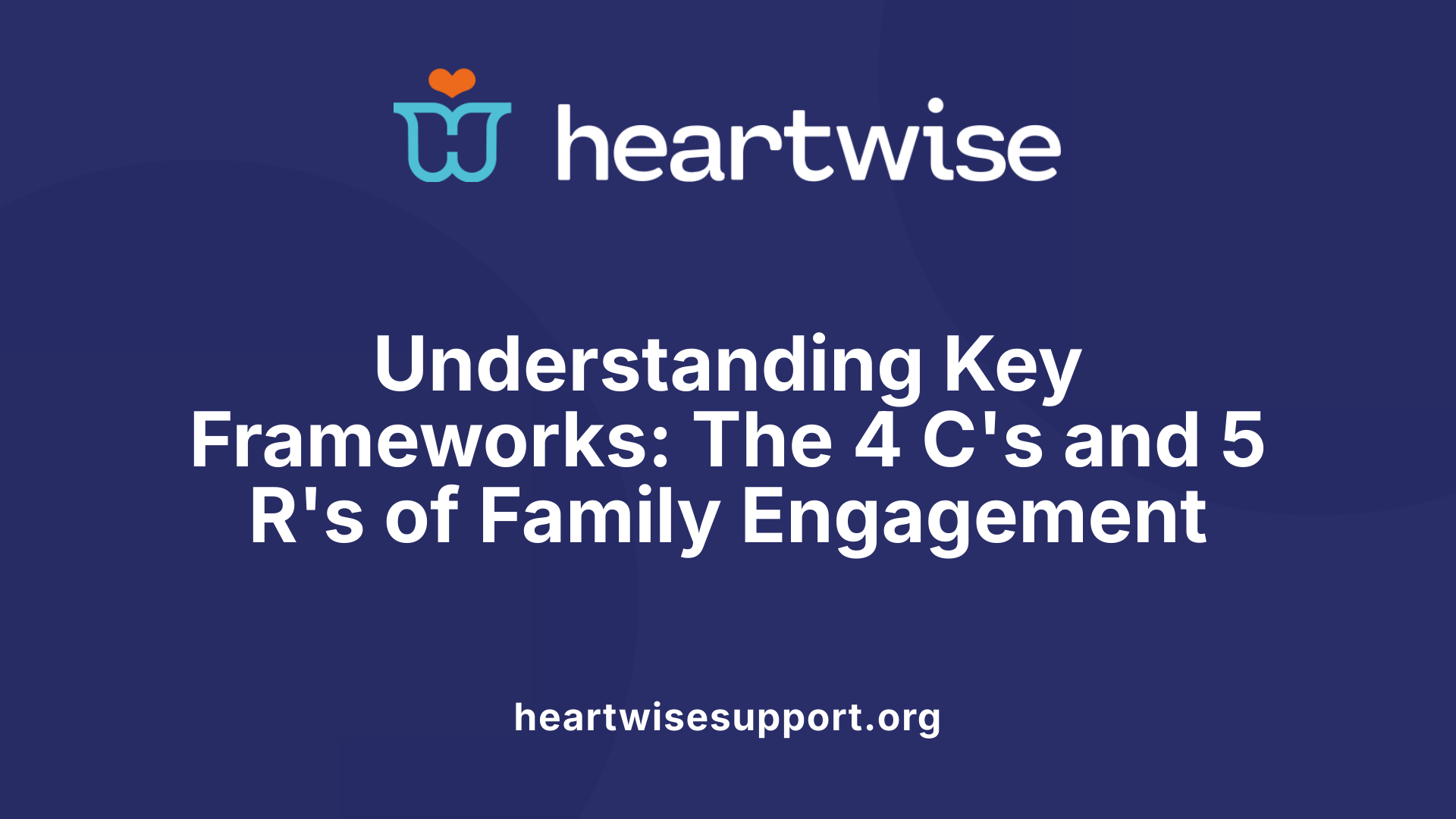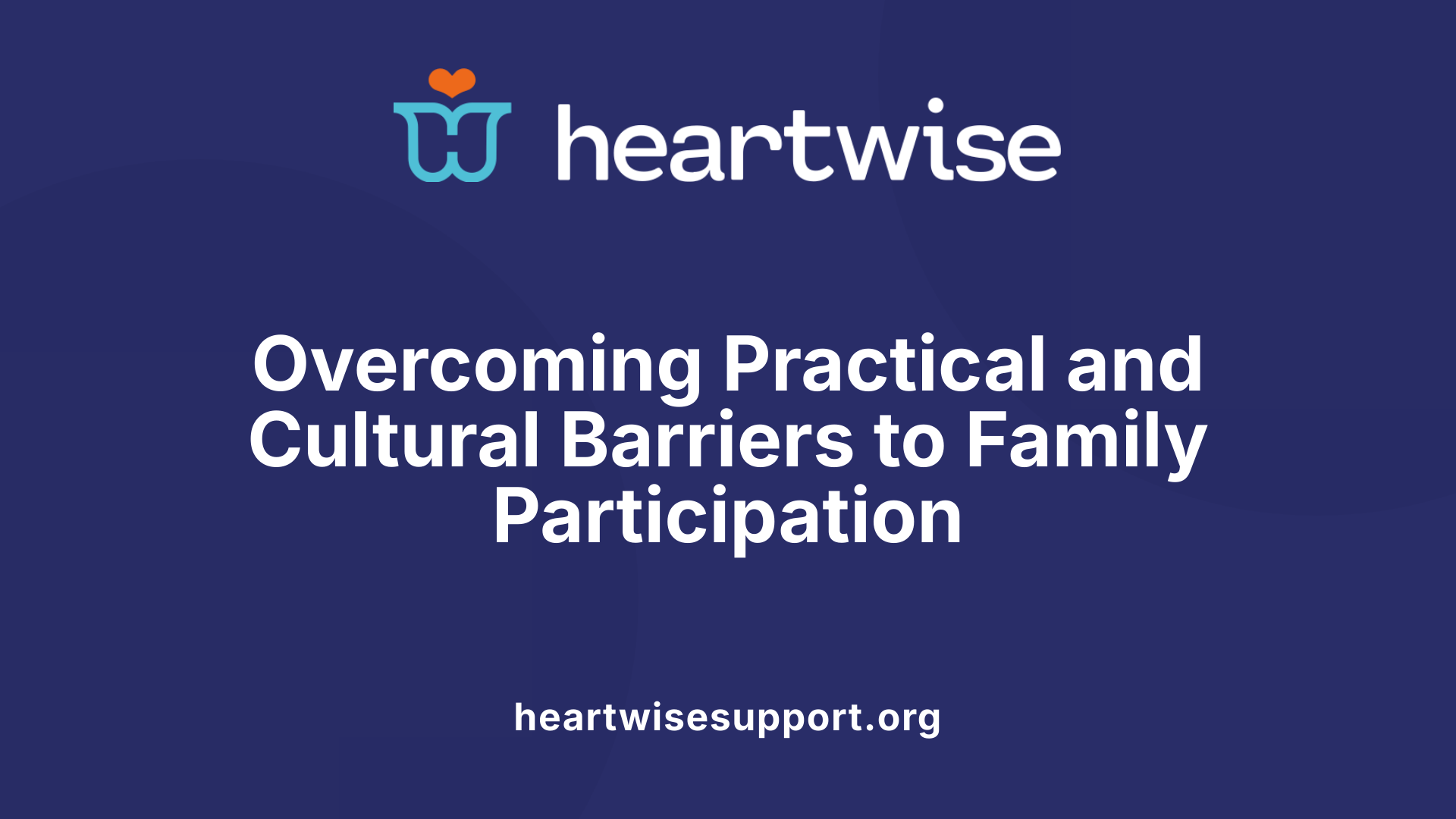Understanding the Foundations of Effective Family Engagement in Therapy
Family engagement in therapy is crucial for achieving meaningful and sustainable mental health outcomes, especially for children, adolescents, and families facing behavioral and emotional challenges. Effective engagement involves more than mere participation; it encompasses active, culturally responsive partnerships that foster trust, collaboration, and shared responsibility. This article explores evidence-based practices, frameworks, and strategies that support families throughout their therapeutic journey, emphasizing the significance of identifying barriers, leveraging strengths, and cultivating a proactive, inclusive environment.
The Role of Family in Mental Health Treatment Outcomes

Why is the family considered the primary support system?
Families are the main source of care and emotional support for most adults and children experiencing mental health issues, as highlighted in the 2000 Surgeon General's mental health report. They serve as the foundation for ongoing support, influencing treatment adherence and long-term recovery.
Families contribute by providing stability, understanding, and encouragement, all of which are essential for sustained mental health improvement. Their active involvement ensures that treatment plans are aligned with the individual’s everyday life, making interventions more practical and sustainable.
How does family involvement impact treatment adherence and success?
Involving family members in mental health treatment significantly enhances engagement and compliance. Family participation enables better understanding of the individual’s challenges, creates a supportive environment for practicing new skills, and fosters resilience.
Research indicates that when families are engaged, clients are more likely to complete treatment programs and experience improved outcomes. Moreover, family support can help address barriers such as stigma, logistical challenges, and emotional stress, thereby reducing dropout rates.
In what ways is family involvement crucial in addressing externalizing disorders and trauma?
Externalizing disorders like conduct and substance abuse disorders respond well to family treatments, especially when parents are actively involved. Family therapy adopts a holistic approach, addressing relationship dynamics, communication, and conflict resolution.
Engagement in family therapy helps families understand trauma impacts and reinforces positive behavioral changes. It also supports managing conflicts within the family unit, which can be pivotal in reducing behavioral problems.
In cases of trauma, involving caregivers fosters a supportive environment that promotes recovery, improves treatment adherence, and enhances skill practice at home. Family-centered interventions are vital for creating a safe space and building trust, especially in marginalized communities where cultural considerations are essential.
Strategies to improve family engagement
Effective engagement begins with early identification of barriers, such as time, transportation, and family stressors. Using reminders, reaching out to key family members, and collaborating with referral sources can enhance participation.
Building a positive therapeutic alliance through trust, respect, and clarity also encourages ongoing involvement. Establishing shared goals, providing practical plans, and addressing both practical and psychological barriers are central steps.
Providing families with education, community resources, and continuous progress monitoring helps sustain engagement. Recognizing and praising family efforts fosters motivation and reinforces their crucial role in treatment success.
Addressing barriers and fostering engagement
Obstacles like internal issues, including mental health problems or cultural beliefs, and external issues such as scheduling conflicts and financial struggles, can impede family participation.
Strategies to overcome these include early barrier assessment, culturally responsive practices, and flexible scheduling. Emphasizing the benefits of treatment, providing clear communication, and involving community organizations further improve engagement.
Leaders and team members across services can promote family involvement by understanding trauma impacts, coordinating care, and supporting family leadership initiatives. Programs like the Building Bridges Initiative and the Family First Prevention Services Act exemplify efforts to enhance family engagement through policy and community-based approaches.
The importance of culturally responsive family engagement
Cultural relevance is pivotal. Connecting with trusted community organizations, translating materials into home languages, and respecting diverse cultural backgrounds can reduce stigma and foster trust.
Implementing practices that incorporate family strengths, resilience frameworks, and social connection strategies helps buffer trauma effects and promotes overall mental health.
Family therapy as a holistic approach
Family therapy emphasizes relationships and dynamics within the family unit, addressing issues such as communication, conflict resolution, and emotional support.
Including family members enhances understanding, treatment engagement, and adherence. It also allows therapists to tailor interventions based on family context, leading to better outcomes.
Supporting family members during therapy fosters resilience and creates a supportive environment for recovery. Strategies like open communication, regular family meetings, and education about mental health are effective.
Benefits of family involvement
In youth substance use treatment, family participation improves relationship quality, reduces adolescent substance use, and increases treatment completion rates.
Similarly, in educational settings, family involvement supports student mental health by building trust, addressing basic needs, and promoting strengths. Culturally responsive engagement, including translating materials and involving community organizations, ensures inclusivity.
Encouraging social-emotional skills such as conflict resolution and perseverance alongside protective factors like social connections and resilience enhances mental health in both children and adults.
Supporting caregivers and educators
Maintaining the mental health of caregivers and educators is crucial because their well-being directly influences their capacity to support children. Providing resources for self-care benefits both parties and creates a healthier support system.
A community-wide effort involving families, schools, and mental health services fosters a comprehensive approach. This collaboration nurtures student well-being and promotes a resilient community.
Family decision-making and leadership
Families are best served when they take a primary role in decision-making regarding children's care. Family leaders, especially those with lived experience, contribute significantly to shaping policies and funding decisions.
Participation can vary from involvement and inclusion to full engagement with shared responsibility. Transparent communication, respect for diversity, and collaboration with community organizations underpin effective family-centered practices.
Systems to support family engagement
Systems of Care (SOC) teams are encouraged to develop family leadership through training, technical assistance, and leadership opportunities. Creating networks and involving families in governance ensures their voices influence service delivery.
Such comprehensive support enhances the effectiveness of mental health services, making them more culturally responsive, sustainable, and aligned with family needs.
| Aspect | Focus | Details |
|---|---|---|
| Family as Support | Primary support system | Main source for emotional and practical support. |
| Treatment Success | Impact of engagement | Better adherence, tailored interventions, and resilience |
| External Factors | Barriers to engagement | Logistics, cultural factors, and stigma |
| Strategies | Enhancing participation | Communication, flexibility, community resources |
| Cultural Responsiveness | Respect diversity | Translation, community involvement, cultural consideration |
| Family Therapy | Holistic, relational approach | Focus on communication, conflict, and support systems |
| Youth Substance Treatment | Family role | Improves relationships, reduces substance use |
| Educational Support | School-family partnership | Supports mental health, builds trust |
| Community Involvement | Building resilience | Social connections, protective factors |
| Leadership & Systems | Family leadership | Policy involvement, training, network development |
Involving families deeply in mental health treatment journeys fosters a more effective, respectful, and culturally sensitive support network, ultimately improving outcomes for individuals and communities alike.
Frameworks and Models Supporting Family Engagement

What are the four C's of family engagement?
The four C's—capabilities, connections, cognition, and confidence—serve as a foundational framework for enhancing family engagement in both educational and therapeutic settings. These elements help evaluate and improve how professionals involve families effectively.
Capabilities refer to families' skills and knowledge necessary for participating meaningfully. Connections emphasize building strong relationships between families and service providers, fostering trust and collaboration. Cognition involves understanding and awareness of the child's needs and the importance of involvement. Confidence relates to families' belief in their ability to contribute and influence decisions.
Structured activities like watching videos featuring experts such as Karen Mapp help build these areas among staff and families. When these elements are strengthened, shared decision-making becomes more effective, leading to more meaningful partnerships. This approach supports a culture of collaboration that promotes better outcomes and family empowerment.
What are the 5 R's of family engagement?
The 5 R's—respect, responsiveness and reassurance, relationship, reciprocity, and reflection—guide the development of trust and active participation between families and educators or service providers.
Respect ensures that families feel valued and their perspectives are honored. Responsiveness and reassurance involve timely and empathetic responses to family concerns, reinforcing their importance. Building Relationships encourages ongoing, genuine connections rooted in mutual understanding.
Reciprocity emphasizes mutual support—both families and professionals contribute to the engagement process. Reflection involves regular assessment of engagement strategies, allowing continuous improvement. These principles foster an inclusive environment that nurtures active family participation, critical for effective support and intervention.
What are the levels of family participation in services?
Families can participate in support and therapy services at various levels—namely involvement, inclusion, and engagement.
Involvement represents basic participation, where families are informed but may not be actively involved or decision-makers. Inclusion takes a step further, involving families actively in decision processes, program planning, and collaborative care.
Engagement is the highest level, characterized by equitable partnerships where families share responsibility, influence policies, and are integrated as vital team members. Recognizing these levels allows practitioners to tailor strategies that deepen family involvement and promote empowerment.
What initiatives promote family engagement in behavioral health?
Programs like the National Building Bridges Initiative and the 2018 Family First Prevention Services Act have played significant roles in fostering family involvement.
The Building Bridges Initiative focuses on understanding family perspectives, enhancing cultural responsiveness, and empowering families to take active roles in treatment planning. Similarly, the Family First Act emphasizes preventative services, family-centered care, and community-based support.
These initiatives are linked to positive outcomes, including shortened treatment durations, improved behavioral health, and enhanced community ties. They promote viewing families not just as participants but as leaders and decision-makers in behavioral health services.
Supporting Family Engagement with Models and Policies
To facilitate effective family engagement, systems adopt various models emphasizing respectful, collaborative, and continuous involvement. Family-centered care models prioritize family's preferences and cultural backgrounds.
System of Care (SOC) teams support this approach by providing training, technical assistance, and creating leadership opportunities for families. Resources include developing parent networks, offering leadership roles, and including families in policy deliberations.
The Building Bridges Model and policies such as the Family First Act exemplify national efforts to institutionalize family engagement by establishing standards and practices that recognize families as essential partners.
Levels of Family Participation in Services
| Level | Description | Examples | Impact |
|---|---|---|---|
| Involvement | Basic awareness or participation without active role | Attending meetings, receiving updates | Awareness, minimal influence |
| Inclusion | Active, meaningful participation in decision-making | Participating in planning sessions | Shared decision-making, collaboration |
| Engagement | Equal partnership, shared responsibility | Families shaping policies, leading initiatives | Empowerment, sustained commitment |
Understanding these distinctions helps organizations develop targeted strategies that encourage ongoing family participation, ultimately improving treatment efficacy and family well-being.
Strategies for Overcoming Barriers and Supporting Family Participation

What are the practical obstacles that hinder family engagement, such as time, transportation, and costs?
Many families face tangible challenges that can impede their active participation in mental health treatments. Practical obstacles often include limited time due to work or family commitments, transportation difficulties preventing attendance at appointments, and financial burdens associated with treatment costs. These barriers can restrict consistent engagement, making it difficult for families to access or sustain services.
Addressing these practical challenges requires targeted strategies. For example, offering flexible scheduling options, providing transportation assistance, or incorporating telehealth services can significantly reduce access issues. Additionally, programs should consider sliding scale fees or free services where possible to alleviate financial hardship, ensuring that practical barriers do not prevent family involvement.
How do family stressors, cultural beliefs, and fears impact engagement?
Family stressors such as ongoing conflicts, mental health challenges, or economic hardship can diminish motivation or capacity to participate in treatment. Cultural beliefs and norms may influence perceptions of mental health, sometimes leading to stigma, mistrust, or rejection of services. Fears related to judgment, discrimination, or losing custody further discourage families from engaging.
Culturally responsive approaches that respect and incorporate family beliefs are essential. Building trust through respectful communication and understanding family perspectives helps to alleviate fears. Engaging cultural liaisons or community leaders in the process can foster a more accepting environment.
What practical strategies can be employed, such as reminders, outreach, and collaboration?
Proactive methods like appointment reminders via phone calls, texts, or emails help families keep track of upcoming sessions. Outreach efforts that involve reaching out to key family members or community organizations can extend the support network and encourage participation.
Collaboration with referral sources, schools, and community groups enhances engagement by creating a coordinated support system. Developing practical plans based on family feedback and setting clear expectations can foster a sense of ownership and commitment.
Why is early contact and trust-building important for engagement?
Establishing early contact with families lays the foundation for a trusting relationship. When families feel welcomed and understood from the outset, they are more likely to stay engaged.
Building trust involves genuine listening, demonstrating respect, and providing consistent, reliable communication. Initial meetings should include warm introductions, clarifying the need for mental health support, and discussing shared goals. This early engagement promotes a positive therapeutic alliance that encourages ongoing participation.
How can addressing internal and external barriers improve treatment outcomes?
Addressing internal barriers such as mental health issues, fears, and cultural beliefs, along with external issues like scheduling conflicts, transportation, and economic struggles, creates a more accessible and responsive treatment environment.
Strategies such as providing culturally sensitive materials, flexible appointment times, and social support services help remove these barriers. When families feel supported and their concerns are acknowledged, they are more likely to commit to and benefit from treatment. These efforts result in higher retention rates, better adherence to treatment plans, and improved overall outcomes.
| Barrier Type | Examples | Support Strategies |
|---|---|---|
| Practical Obstacles | Time constraints, transportation, costs | Flexible scheduling, telehealth, sliding scale fees |
| Family Stressors | Conflict, economic hardship, mental health issues | Counseling support, family strengthening programs |
| Cultural and Psychological Barriers | Stigma, fears, cultural norms | Cultural competence training, community engagement, respectful communication |
Understanding and systematically addressing these barriers can transform engagement from a challenge into an opportunity for meaningful family involvement. Building trust, providing practical support, and fostering a collaborative environment are essential practices that support families throughout the treatment process.
How can all MDT partners contribute to fostering family engagement?
Multidisciplinary team (MDT) partners can play crucial roles in understanding trauma impacts, conducting comprehensive assessments, and developing tailored service plans. They can facilitate communication, provide ongoing monitoring, and utilize their specific expertise to support family participation.
Together, these partners can coordinate efforts to include families at every step, ensuring their voices are heard in decision-making processes. Training in trauma-informed care and cultural responsiveness equips the team to better serve diverse families, promoting a sense of safety and belonging.
What are evidence-based approaches to enhance engagement?
Effective engagement relies on strategies such as maintaining open, transparent communication about treatment goals, and showing empathy to build rapport.
Developing shared goals with families, respecting their cultural backgrounds, and providing clear information about the benefits of treatment foster active participation. Using community resources, providing bilingual materials, and ensuring that families understand their role in the process enhance trust.
Monitoring progress and praising efforts reinforce positive engagement. Incorporating family peer support models and digital communication tools like online portals can further boost involvement and sustain motivation.
| Engagement Strategy | Description | Expected Outcome |
|---|---|---|
| Early contact and trust-building | Initiate contact early, establish rapport, clarify needs | Increased retention, stronger partnerships |
| Practical support and flexibility | Remain adaptable to family schedules, provide transportation, reduce costs | Higher attendance, ongoing participation |
| Cultural responsiveness and partnership | Incorporate cultural beliefs, collaborate with community organizations | Reduced stigma, improved cultural fit, enhanced trust |
| Use of digital and peer support models | Online portals, family peer support, transparent communication | Sustained engagement, family empowerment |
By actively implementing these strategies, treatment providers can foster meaningful, enduring family engagement. This holistic approach supports better mental health outcomes and strengthens family resilience.
The Future of Family Engagement in Therapeutic Practice

What innovative approaches are shaping future family engagement strategies?
Emerging practices emphasize technological integration and cultural responsiveness to foster stronger family involvement. Online portals are becoming pivotal, offering families a secure platform to communicate with providers, access resources, and monitor progress conveniently from home. This reduces logistical barriers like transportation and scheduling conflicts.
Family peer support models are gaining recognition for their effectiveness. These models involve individuals with lived experience of mental health challenges providing guidance and support to families, creating relatable and empowering connections. Additionally, translating materials into multiple languages ensures information is accessible to diverse communities, enhancing inclusivity.
Why is discharge planning important from the moment of intake?
Starting discharge planning at intake helps set clear expectations and fosters early engagement. It encourages families to envision the end goals of treatment, which enhances motivation and commitment. By integrating discharge strategies early, clinicians can better tailor interventions, ensuring a smoother transition to ongoing support or community-based resources.
How does ongoing communication and feedback improve family engagement?
Consistent, transparent communication builds trust and keeps families informed about their loved ones’ progress. Regular feedback mechanisms allow families to share their experiences and concerns, which can guide treatment adjustments. Using tools such as surveys or follow-up calls ensures families feel heard and valued, supporting sustained involvement.
How do cultural responsiveness and continuous improvement shape future practices?
Cultural responsiveness involves understanding and respecting family backgrounds, beliefs, and languages. Tailoring engagement approaches to reflect families’ cultural contexts reduces mistrust and stigma, especially in marginalized communities. Continual evaluation of engagement strategies through family feedback promotes ongoing improvement, ensuring practices remain relevant and effective.
What are the four C's of family engagement?
The four C's—capabilities, connections, cognition, and confidence—are essential for effective family involvement. These elements assess and enhance how families participate in school or therapy settings. Building capabilities and confidence enables families to navigate systems effectively, while fostering connections and cognition helps deepen understanding and shared decision-making. Activities like watching expert-led videos or participating in structured workshops support the development of these aspects, promoting collaborative partnerships.
What are the five R's that foster meaningful family relationships?
Respect, responsiveness and reassurance, relationship, reciprocity, and reflection make up the five R's. They serve as guiding principles that cultivate trust and mutual support. Demonstrating respect and being responsive reassure families that their perspectives matter. Reciprocity encourages mutual support, and reflecting on engagement practices allows continuous improvement, creating an inclusive and supportive environment.
How do levels of family participation influence service delivery?
Families engage at levels ranging from involvement, inclusion, to engagement. Involvement might be passive participation, such as attending meetings. Inclusion involves active contribution in decision-making processes, fostering a sense of ownership. Engagement is the most collaborative level, where families share responsibility equally with professionals, influencing policies and treatment plans. Recognizing these levels helps tailor approaches that promote empowerment and deeper involvement.
| Level of Participation | Description | Example Actions |
|---|---|---|
| Involvement | Basic participation without decision-making | Attending therapy sessions |
| Inclusion | Active, meaningful participation | Sharing insights in planning meetings |
| Engagement | Shared responsibility, partnership | Co-developing treatment goals |
What future practices are essential to enhancing family engagement?
Incorporating innovative tools such as online portals and peer support will increase accessibility. Early discharge planning from intake fosters clearer pathways for family involvement. Continuously gathering and acting on family feedback ensures practices remain relevant. Focusing on cultural responsiveness—through translated materials and community partnerships—strengthens trust. Combining these elements ensures engagement strategies are adaptable, personalized, and effective, leading to better outcomes for families and individuals.
In summary, the future of family engagement lies in embracing technology, fostering early and continuous communication, respecting cultural differences, and empowering families to act as active partners. Through these innovative approaches, practitioners can create more inclusive, effective, and sustainable treatment environments that truly meet families’ unique needs.
Fostering a Collaborative and Culturally Responsive Future
Supporting family engagement in therapy is fundamental to achieving effective, lasting mental health improvements. Emphasizing trust, open communication, cultural responsiveness, and evidence-based practices creates a foundation for active, meaningful partnerships. As initiatives evolve and new technologies emerge, ongoing training for providers and inclusive policies will be key to overcoming barriers and strengthening family involvement. Building a future where families are true partners in therapy requires sustained commitment, innovative strategies, and respect for diversity—ultimately leading to more resilient families and healthier communities.
References
- [PDF] Evidence-Based Strategies for Family Engagement
- [PDF] Family Engagement and Involvement in Trauma Mental Health
- The Integral Role of Families in Promoting Mental Health and ...
- Why Family Participation is Vital in Therapy Sessions
- Retention Toolkit: Family Involvement - UW ADAI
- Supporting Student Mental Health via Family Engagement
- Engaging Families in System of Care - PA Care Partnership
- [PDF] Activity 5.1: The 4 Cs Time - PaTTAN











